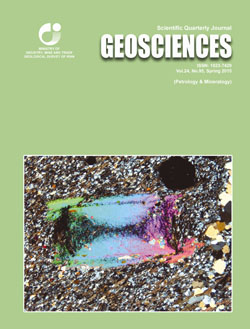Document Type : Original Research Paper
Authors
1 Assistant Professor, Faculty of Geology, University of Shahrood, Shahrood, Iran
2 M. Sc. Student, Faculty of Geology, University of Shahrood, Shahrood, Iran
Abstract
The Challu granitoidic pluton composes of two monzodiorite and quart diorite units, injected into the Eocene volcanic rocks in south of Damghan. Emplacement mechanism of this pluton has been investigated by the anisotropy of magnetite susceptibility method. The measured mean value of bulk susceptibility (Km in µSI) in fresh quart zdiorites and monzonites are 31608 and 33726, respectively and then the pluton belongs to the ferromagnetite granites. In this granitoidic body, magnetite is the main carrier of magnetic susceptibility and biotite and pyroxene are the other accessory factors of magnetite nature. The field observation along with petrographical and magnetic fabric investigations reveal that the mentioned pluton emplaced at two stages with two different mechanisms. Monzodioritic unit with dominant porphyroidic texture and NS lineation trend and foliation strike parallel to the margin of the pluton emplaced along tensional gash of one dextral shear zone. Quartz dioritic unit at the same time or a time after monzodiorite emplaced as dyke. The magnetic fabric pattern, oblate ellipsoid shape as well as predominance of trachytoidic texture in this unit correspond with the inverse fabric dyking pattern and the orientation of plagioclase show magma flow. The magnetic susceptibility has been decreased in the stations that subjected to the hydrothermal alteration either by reduction of size of magnetite crystals or conversion of magnetite to hematite. The microstructures in the pluton are mainly magmatic and show high melt fraction to crystal during the emplacement or absence of tectonic stress after full crystallization.
Keywords

